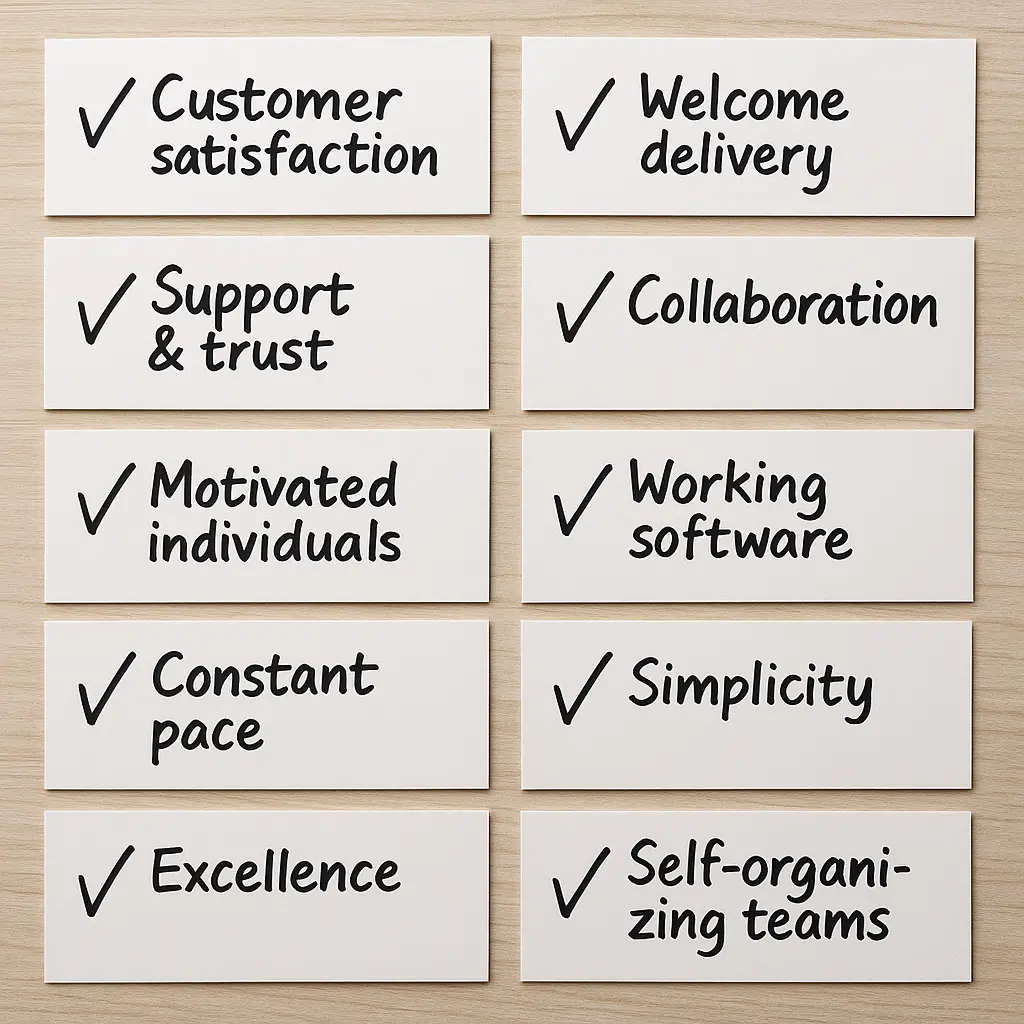Understanding the PMBOK® 7th Edition Principles and the Guide
Author: Hajime Estanislao, PMP®; Editor: Geram Lompon; Reviewed by: Alvin Villanueva, PMP®, PMI-ACP®
Many teams are tied to workflows that reward completion over value, checklists over clarity, and activity over impact. However, work has changed, and effective collaboration among team members is foundational for
The PMBOK® Guide 7th Edition was a response to this shift. It introduces 12 core principles that help project managers lead with confidence, especially when the path is complex. These principles are not bound to a single methodology. Instead, they support
Imagine approaching every project with clarity, focused stakeholder engagement, and a delivery mindset rooted in outcomes. The 12 principles help build that foundation for achieving quality outcomes. They enable teams to deliver projects, produce change, and have a measurable impact, all directed toward achieving project objectives.
And if you are preparing for the CAPM certification, these principles are more than helpful. Understanding how to apply
In this article, we will introduce the 12 principles, how they work in practice, and explain why they are becoming the new standard.

What Is Project Management
At its core,
The principles of
What are the 12 Principles?
The 12 principles introduced in the PMBOK Edition reflect a modern, outcome-focused approach to managing projects. Unlike previous guides built around step-by-step processes and static documentation, these principles promote behavioral guidance, including the risk principle. They do not dictate how to run a project; they shape how to lead, decide, and adapt within any
Each principle reflects a real-world challenge project managers face: changing requirements, diverse stakeholders, shifting priorities, and the demand for transparency. Together, they form a flexible framework that applies across delivery approaches, ensuring teams can identify risks effectively.
These principles help you monitor project progress :
- Align your work with stakeholder expectations
- Keep focus on value delivery and meaningful outcomes
- Respond to change while preserving direction
- Build trust, collaboration, and accountability across project team members
- Lead with purpose in any organizational context
Examples in context:
- Managing cross-functional teams? Utilize principles like a collaborative team environment and leadership behaviors to build trust and cohesion.
- Navigating uncertainty? Lean on risk response, adaptability, and complexity principles to stay agile and steady.
- Dealing with competing demands? Apply a value-focused approach and system interaction to prioritize and communicate effectively.
These principles form the core of modern project delivery, helping to turn knowledge into action and keeping teams aligned, stakeholders engaged, and progress grounded in purpose.

Reasons You Need to Understand the Context of the 12 Principles
Knowing what the 12 principles are is relevant, but it is not enough. To apply them, you must understand their purpose and see how they operate within your specific project context.
It is where your skills as a project professional make the difference. When you understand the why behind each principle, you can use it strategically. You move from following guidance to leading with intention.
Why contextual understanding matters:
- Helps you connect the principle to the right situation
- Encourages more relevant and project-specific tailoring
- Builds confidence in ambiguous or politically complex settings
- Improves decision-making by focusing on what matters most
- Strengthens alignment between project work and business goals
- Boosts team trust by reinforcing transparent reasoning
- Helps embed the principles into everyday practices, not just plans
- Supports ethical behavior and leadership credibility
- Reinforces a shared language across teams and stakeholders
- Anchors your project in outcomes, not just activity
Understanding context is not extra work. It is what makes these principles practical.

Project Goals and Objectives
Every effective project begins with an understanding of the desired outcomes. That clarity comes from well-articulated project goals and objectives, not just task lists or timelines. Goals define where to go. Objectives: create the path.
A strong goal communicates intent in terms of value, impact, or change. Objectives translate that intent into specific, measurable efforts. Together, they ensure your project is complete and meaningful.
Project managers must navigate varied stakeholder expectations, align work with the broader organizational context, and ensure project activities support the intended project outcomes. Setting goals without engaging key stakeholders or understanding business needs results in work that is complete but misses the mark. When goals are grounded in context and objectives are tailored to stakeholder priorities, the result is shared ownership and successful delivery.

12 Principles of Project Management
Here are the 12 Principles from the PMBOK Guide Edition, which are recognized as the fundamental principles that support modern
1. Be a Diligent, Respectful, and Caring Steward
This principle centers on responsible leadership, protecting resources, acting ethically, and considering the long-term impact of your decisions.
Example:
A project manager resists cutting corners under pressure and instead negotiates a revised timeline that protects both delivery and team well-being.
2. Create a Collaborative Project Team Environment
A culture of trust, psychological safety, and open communication drives better outcomes than micromanagement or blame, emphasizing and promoting collaboration.
Example:
Instead of blaming when a milestone is missed, the team leads a review session focused on shared learning and future prevention.
3. Effectively Engage with Stakeholders
Engagement is not a formality. It is a continuous relationship built through empathy, transparency, and listening.
Example:
A stakeholder feedback loop is built into sprint reviews, enabling users to influence the product’s development as it evolves.
4. Focus on Value
Projects are investments. Everything you plan, build, and deliver should connect to tangible or perceived value, especially in the context of complex projects.
Example:
A team removes low-impact features from the backlog and reallocates effort toward improving core user functionality.
5. Recognize, Evaluate, and Respond to System Interactions
No decision exists in isolation. This principle encourages you to consider how actions impact the broader organizational and technical environment.
Example:
A change in project workflow triggers an early conversation with the compliance team to avoid downstream issues.
6. Demonstrate Leadership Behaviors
Leadership reflects consistency, humility, and vision, not just status updates or authority.
Example:
A team lead openly acknowledges a poor decision and outlines how lessons learned will inform future planning.
7. Tailor Based on Context
No two projects are the same. Tailoring means selecting tools, methods, and practices that suit your environment, rather than unthinkingly following a template.
Example:
On a small marketing project, the manager ditches a formal WBS and opts for a shared task board and weekly 30-minute standups.
8. Build Quality into Processes and Deliverables
Quality is not an afterthought. It is a design choice. This principle promotes early attention to standards, continuous feedback, and clear definitions of done.
Example:
Each sprint includes time for internal QA and customer-facing demos to identify and resolve complex issues, leading to final delivery.
9. Navigate Complexity
Complexity arises from scale, pace, and the interplay of people and systems can’t be ignored. The goal is not to control it, but to understand and respond thoughtfully.
Example:
A mid-project change to regulatory policy prompts a cross-functional session to reevaluate risks and adjust the scope.
10. Optimize Risk Responses
Risk is not just a log but a conversation. Proactive identification, thoughtful prioritization, and flexible mitigation drive better outcomes.
Example:
The team builds in contingency time for a vendor hand-off they suspect may slip, and uses it when the delay occurs.
11. Embrace Adaptability and Resiliency
Change is constant. Resilient teams bend but don’t break, and they respond, learn, and continue delivering.
Example:
When supply delays stall a hardware roll-out, the team shifts focus to user training, maintaining momentum while waiting.
12. Enable Change to Achieve the Envisioned Future State
A project is not successful until its outcomes are used, accepted, and sustained. Adoption matters.
Example:
After launching a new CRM, the project team stays involved to train users, gather adoption feedback, and tweak workflows.

Project Management Methodologies
Different projects call for various structures, guided by effective project plans. While agile, Scrum, and Waterfall remain the dominant approaches, the value lies in knowing when and how to apply them effectively.
Agile promotes flexibility, fast feedback, and continuous delivery. Waterfall works well for linear scopes. A hybrid approach is tailored to context, complexity, and pace.
What ties them together is the
Project Management Tools and Techniques
Behind every strong project manager is a carefully chosen set of tools. Planning tools help visualize scope and timelines. Risk management tools support early intervention. Collaboration tools facilitate stakeholder engagement and team communication.
Tools alone do not deliver outcomes; it is the principles that do. When selected purposefully and used with a clear understanding of quality standards, change management, and risk response, these tools amplify your ability to deliver.
Whether managing complexity across global teams or executing local campaigns, combining these techniques with clear principles helps ensure consistent, quality-driven project outcomes across multiple projects.

Considerations: The Bodies of Knowledge Coexist
The 6th and 7th Editions of the PMBOK Guide should coexist. They are complementary perspectives. Where the Edition offers structure, processes, and defined outputs, the 7th provides the principles and performance domains that help you navigate complex projects.
Together, they offer breadth and depth. Need help defining your performance management baseline? Start with the 6th. Need to lead in a high-change environment with multiple stakeholders? Bring in the 7th.
Project managers do not choose one but tailor their structure and mindset to the situation. That’s where maturity happens. And that’s how projects become more than tasks; they become transformative efforts aligned with value.
Wrapping Up: Into the Future
The 12 principles of the PMBOK Guide – 7th Edition signal where
For new professionals, these principles are your gateway to becoming a trusted project leader. For seasoned practitioners, they are a reminder that even established practices can evolve.
If you are preparing for the CAPM certification or simply ready to manage with more clarity and flexibility, ROSEMET LLC is here to help. We make the
Lead with purpose. Learn with ROSEMET.
References
Project Management Institute. (2017). A guide to the project management body of knowledge (PMBOK® Guide) (6th ed.).
Project Management Institute. (2021). A guide to the project management body of knowledge (PMBOK® Guide) (7th ed.).
Project Management Institute. (2021). The 12 project management principles . https://www.pmi.org/-/media/pmi/documents/public/pdf/pmbok-standards/12-project-management-principles.pdf

